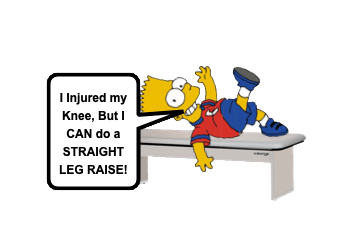Patellar Tendon Rupture

Sports are wonderful to be involved in! They promote teamwork, selflessness, and healthy habits! With all of the positive aspects, there are also some hazards. We have discussed many other sporting-related injuries (ex, Little League Shoulder, Horse Related Injuries, Commotio Cordis, Heat Related Illness). The knee is an at risk component that can become injured easily, but there is one very important condition we must consider when evaluating all knee injuries – Patellar Tendon Rupture:
The Extensor Mechanism
- The extensor mechanism of the knee is ESSENTIAL to ambulation and knee stabilization!
- Primary purpose of it is to overcome gravity. [Dupuis, 2009]
- Ambulating
- Rising from seated position
- Ascending / Descending stairs
- Stabilization during standing
- The patella functions to improve mechanical advantage of the quadricep muscle.
- Primary purpose of it is to overcome gravity. [Dupuis, 2009]
- Problems with the knee extensor mechanism can be related to [Dupuis, 2009]:
- Trauma
- Inflammatory Processes
- Congenital Malformations
- The knee extensor mechanism includes: [Dupuis, 2009]
- Quadriceps
- Attachment to Pelvis (Anterior Superior Inferior Iliac Spine)
- Quadriceps muscle group
- Quadricep tendon and its patellar attachments
- Patella
- Patellar Tendon
- Patellar tendon insertion onto Tibia
- Quadriceps
- Any pathologic process along the entire length of the extensor mechanism can jeopardize its function and stability.
- Pelvic Avulsion
- Quadricep Muscle injury or inflammation
- Quadricep Tendonitis or Rupture
- Patella Dislocation or Fracture
- Patellar Tendonitis or Rupture
- Osgood-Schlatter’s Disease
- Children’s Growth Plates add increased risk for concurrent bony avulsions. [Yousef, 2017]
Patellar Tendon Rupture
- Patellar tendon rupture is rare overall.
- Represents only 0.6% of tendon injuries in the general population. [Yousef, 2017]
- Peak incidence = ~40 years of age
- Pediatric Patellar tendon rupture has become more common. [Yousef, 2017]
- Has accounted for 7% of pediatric patients who sustain acute knee trauma. [Yousef, 2017]
- Often related to Sports Activities, which has also become more common. [Yousef, 2017]
- Basketball
- Gynmastics
- Hurdling
- Mean age for children = ~13 years [Yousef, 2017]
- Patellar tendon rupture occurs when: [Yousef, 2017]
- The quadricep muscle applies a strong, eccentric force,
- While the foot is planted and the…
- Knee is flexed.
- Predisposing conditions may allow for rupture to occur with lower forces.
- Systemic inflammatory conditions (ex, Lupus)
- Osteogenesis imperfecta
- Diabetes
- Chronic renal failure
- Local steroid injection
- Repeated micro-trauma (as might occur in athletes)
Patellar Tendon Rupture: Evaluation
- The initial diagnosis is challenging! [Yousef, 2017]
- Non-specific findings are common among all knee injuries:
- Immediate pain and swelling
- Limited range of motion
- Normal anatomic alignment
- Many times, patellar tendon rupture is missed and this increases morbidity. [Yousef, 2017]
- Non-specific findings are common among all knee injuries:
- Look specifically for:
- High-riding patella compared to other leg.
- Tenderness and/or palpable defect between the patella and the tibial tubercle.
- Inability to perform straight leg raise!
- X-rays can help, but are not conclusive.
- Joint effusion and High riding Patella may be seen. [Yousef, 2018]
- May see small detached fragment along the line of the patellar tendon which likely represents an avulsed periosteal flap attached to the tendon.
- MRI is used to confirm the diagnosis.
- Early surgical repair is the treatment of choice! [Yousef, 2017]
- Patellar Tendon rupture is considered a serious injury.
- Leads to better functional outcomes.
- Early diagnosis and appropriate referral is critical.
Moral of the Morsel
- Keep a High Index of Suspicion! Patellar Tendon Rupture is rare, but can be easily missed and that can increase morbidity.
- Straight Leg Raise is the most important aspect of the knee exam! Make all patients with knee pain do this!
References
Yousef MAA1. Combined avulsion fracture of the tibial tubercle and patellar tendon rupture in pediatric population: case series and review of literature. Eur J Orthop Surg Traumatol. 2018 Feb;28(2):317-323. PMID: 28956182. [PubMed] [Read by QxMD]
Ali Yousef MA1, Rosenfeld S2. Acute traumatic rupture of the patellar tendon in pediatric population: Case series and review of the literature. Injury. 2017 Nov;48(11):2515-2521. PMID: 28888715. [PubMed] [Read by QxMD]
Dupuis CS1, Westra SJ, Makris J, Wallace EC. Injuries and conditions of the extensor mechanism of the pediatric knee. Radiographics. 2009 May-Jun;29(3):877-86. PMID: 19448122. [PubMed] [Read by QxMD]

